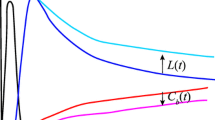Abstract
A non-invasive, simple method for the quantitative evaluation of brain perfusion is presented using intravenous radionuclide angiography with technetium-99m hexamethylpropylene amine oxime (99mTc-HMPAO). Graphical analysis was employed for the evaluation of the unidirectional influx constant (k u of the tracer from the blood to the brain. The k u values were standardized to provide objective and comparable values, brain perfusion indices (BPI), among studied subjects by setting the ratio of ROIbrain size to ROIaorta size at 10. The wholebrain BPI values for the normal control subjects showed a significant negative correlation with advancing age (r = -0.632, P =0.0204, n =13). The mean of the wholebrain BPI of 7.0 (SD =1.4) in 20 patients with cerebrovascular disorders was significantly lower than that of 10.6 (SD =1.5) in 13 normal control subjects. The BPI measurements showed only minimal intra- and interobserver variability. Changes of the ratio of ROIaorta size and ROIbmin size did not significantly influence the BPI values. Hemispherical BPI values in 19 subjects (n =38) showed highly significant correlations with the hemispherical mean cerebral blood flow values obtained from Xenon-133 single photon emission tomography (SPET) (r =0.926, P =0.0001 for the early picture method and r =0.932, P =0.0001 for the sequential picture method). This technique is easy to apply as an adjunct to SPET and may be helpful in the quantitative evaluation of brain perfusion in routine clinical studies.
Similar content being viewed by others
References
Andersen AR (1989) 99mTc-D,L-hexamethylene-propyleneaminexime (99mTc-HMPAO): basic kinetic studies of a tracer of cerebral blood flow. Cerebrovasc Brain Metabol Rev 1:288–318
Andersen AR, Fridberg H, Lassen NA, Kristensen K, Neirinckx RD (1988) Assessment of the arterial input curve for [99mTc]-d,l-HMPAO by rapid octanol extraction. J Cereb Blood Flow Metabol 8 [Suppl 1]:S23-S30
Gjedde A (1981) High- and low-affinity transport of d-glucose from blood to brain. J Neurochem 36:1463–1471
Higashi S, Matsuda H, Fujii H, Ito H, Yamashita J (1989) Luxury perfusion syndrome confirmed by sequential studies of regional cerebral blood flow and volume after extracranial to intracranial bypass surgery: case report. Neurosurgery 25:85–89
Inugami A, Kanno I, Uemura K, Shishido F, Murakami M, Tomura N, Fujita H, Higano S (1988) Linearization correction of 99mTc-labeled hexamethyl-propylene amine oxime (HMPAO) image in terms of regional CBF distribution: comparison to C15O2 inhalation steady-state method measured by positron emission tomography. J Cereb Blood Flow Metabol 8 [Supp 11]:S52-S60
Kanno I, Lassen NA (1979) Two methods for calculating regional cerebral blood flow from emission computed tomography of inert gas concentrations. J Comput Assist Tomogr 3:71–76
Lassen NA, Andersen AR, Fridberg L, Paulson OB (1988) The retention of [99mTc]-d,l-HMPAO in the human brain after intracarotid bolus injection: a kinetic analysis. J Cereb Blood Flow Metabol 8 [Suppl 1]:S13-S22
Maeda T, Matsuda H, Hisada K, Tonami N, Mori H, Fujii H, Hayashi M, Yamamoto S (1981) Three-dimensional cerebral blood perfusion images with single photon emission computed tomography. Radiology 140:817–822
Matsuda H, Maeda T, Yamada M, Luo X-G, Tonami N, Hisada K (1984) Age-matched normal values and topographic maps for regional cerebral blood flow measurements by Xe-133 inhalation. Stroke 15:336–342
Matsuda H, Seki H, Sumiya H, Tsuji S, Tonami N, Hisada K, Fujii H, Kobayashi H (1986) Quantitative cerebral blood flow measurements using n-isopropyl-(iodine 123)p-iodoamphetamine and single photon emission computed tomography with rotating gamma camera. Am J Physiol imaging 1:186–194
Matsuda H, Oba H, Seki H, Higashi S, Sumiya H, Tsuji S, Terada H, Imai K, Shiba K, Mori H, Hisada K (1988) Determination of flow and rate constants in a kinetic model of [99m-Tc]-hexamethyl-propylene amine oxime in the human brain. J Cereb Blood Flow Metabol 8 [Suppl 1]:S61-S68
Melamed E, Lavy S, Bentin S, Cooper G, Rinot Y (1980) Reduction in regional cerebral blood flow during normal aging in man. Stroke 11:31–35
Naritomi H, Meyer JS, Sakai F, Yamaguchi F, Shaw T (1979) Effects of advancing age on regional cerebral blood flow. Arch Neurol 36:410–416
Patlak CS, Blasberg RG, Fenstermacher JD (1983) Graphical evaluation of blood-to-brain transfer constants from multiple-time uptake data. J Cereb Blood Flow Metabol 3:1–7
Patlak CS, Blasberg RG (1985) Graphical evaluation of blood-to-brain transfer constants from multiple-time uptake data. Generalizations. J Cereb Blood Flow Metabol 5:584–590
Author information
Authors and Affiliations
Additional information
Offprint requests to: H. Matsuda
Rights and permissions
About this article
Cite this article
Matsuda, H., Tsuji, S., Shuke, N. et al. A quantitative approach to technetium-99m hexamethylpropylene amine oxime. Eur J Nucl Med 19, 195–200 (1992). https://doi.org/10.1007/BF00173281
Received:
Revised:
Issue Date:
DOI: https://doi.org/10.1007/BF00173281




